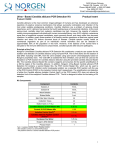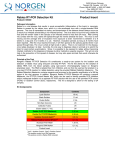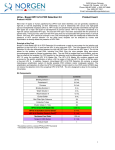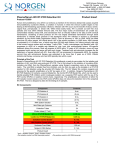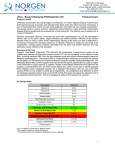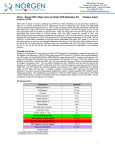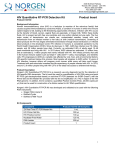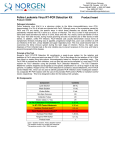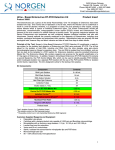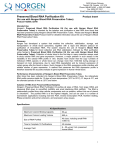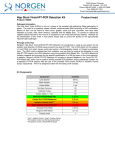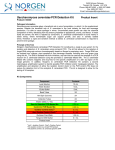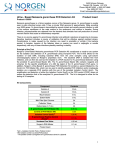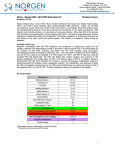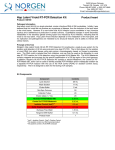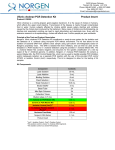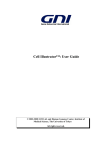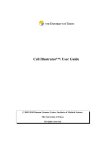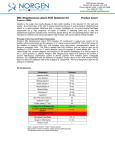Download Urine-Based HIV RT-PCR Detection Kit - Protocol
Transcript
3430 Schmon Parkway Thorold, ON, Canada L2V 4Y6 Phone: 866-667-4362 (905) 227-8848 Fax: (905) 227-1061 Email: [email protected] Urine - Based HIV RT-PCR Detection Kit Product Insert Product # 33700 Human immunodeficiency virus (HIV) is a lentivirus (a member of the retrovirus family) that causes acquired immunodeficiency syndrome (AIDS), a condition in humans in which the immune system begins to fail, leading to life-threatening opportunistic infections. Infection with HIV occurs by the transfer of blood, semen, vaginal fluid, pre-ejaculate, or breast milk. Within these bodily fluids, HIV is present as both free virus particles and virus within infected immune cells. The four major routes of transmission are unsafe sex, contaminated needles, breast milk, and transmission from an infected mother to her baby at birth (vertical transmission). Screening of blood products for HIV has largely eliminated transmission through blood transfusions or infected blood products in the developed world. HIV infection in humans is considered pandemic by the World Health Organization (WHO). From its discovery in 1981 to 2006, AIDS has killed more than 25 million people. HIV infects about 0.6% of the world's population. In 2005 alone, AIDS claimed an estimated 2.4–3.3 million lives, of which more than 570,000 were children. HIV infects primarily vital cells in the human immune system such as helper T cells (CD4+ T cells), macrophages, and dendritic cells. HIV progresses to AIDS at a variable rate affected by viral, host, and environmental factors; HIV-specific treatment delays this process. Most will progress to AIDS within 10 years of HIV infection: some will have progressed much sooner and some will take much longer. Treatment with anti-retrovirals increases the life expectancy of people infected with HIV. Even after HIV has progressed to diagnosable AIDS, the average survival time with antiretroviral therapy was estimated to be more than 5 years as of 2005. Without antiretroviral therapy, someone who has AIDS typically dies within a year. Principle of the Test Norgen’s Urine-Based HIV RT-PCR Detection Kit constituents a ready-to-use system for the isolation and detection of HIV viral RNA using end-point RT-PCR. The kit first allows for the isolation of total RNA, including viral RNA, from the urine samples using spin-column chromatography based on Norgen’s proprietary resin. The viral RNA is isolated free from inhibitors, and can then be used as the template in a PCR reaction for HIV detection using the provided HIV Master Mix. The HIV Master Mix contains reagents and enzymes for the specific amplification of a 297 bp region of HIV. In addition, Norgen’s Urine-Based HIV RT-PCR Detection Kit contains a second heterologous amplification system to identify possible PCR inhibition and/or inadequate isolation. The amplification and detection of either the HIV Isolation Control (IsoC) or the PCR control (PCRC) does not reduce the detection limit of the analytical HIV PCR. The kit is designed to allow for the testing of 24 samples. Kit Components: Component Contents RNA Lysis Solution 3 x 90 mL RNA Wash Solution 24 mL RNA Elution Solution Mini Filter Spin Columns Collection Tubes 6 mL 24 24 Elution tubes (1.7 mL) 24 HIV 2x RT-PCR Master Mix 0.35 mL Control 2x RT-PCR Master Mix 0.35 mL Isolation Control * a HIV Positive Control (PosC)* * a b 0.3 mL b 0.1 mL Nuclease-Free Water 1.25 mL Norgen’s DNA Marker 0.1 mL Product Insert 1 IsoC= Isolation Control; PosC= Positive Control The positive control is an in vitro transcribed HIV RNA fragments. The isolation control is a cloned PCR product 1 Customer-Supplied Reagents and Equipment Disposable Latex gloves Centrifuge with a swinging bucket rotor capable of 2000 x g Benchtop microcentrifuge Micropipettes with an accuracy range between 1-10 µL, 10-100 µL and 100-1000 µL Laminar flow hood for extractions Vortex Sterile, nuclease-free aerosol-barrier micropipettor tips Microcentrifuge tube rack PCR tubes 96 – 100% ethanol -mercaptoethanol 50 mL conical tubes Storage Conditions and Product Stability The Positive Control (HIV PosC, red cap) and Isolation Control (IsoC, orange cap) should be stored at -70°C. If needed, make aliquots of the controls according to the volume used in the protocol (10 L of HIV PosC or 10 L of HIV IsoC) prior to freezing. The HIV 2X RT-PCR Mastermix (green cap) and the Control 2X RT-PCR Mastermix (yellow cap) should be stored at -20°C. Make appropriate aliquots if needed All other kit components may be stored at room temperature The HIV 2X RT-PCR Mastermix, the Control 2X RT-PCR Mastermix, the Control 2X RT-PCR Mastermix and Isolation Control (IsoC) should not undergo repeated freeze-thaw (a maximum freeze-thaw of three times). Do not use kit or reagents past their expiration dates Allow reagents to thaw at room temperature prior to use Kit reagents are stable through the end of the expiration month indicated on the packaging label when stored at the recommended temperatures. For RT-PCR o Allow reagents to thaw at room temperature prior to use o When thawed, mix the components and centrifuge briefly o Work quickly on ice o After addition of RT-PCR Mastermix use within one hour General Precautions Follow universal precautions. All patient specimens should be considered as potentially infectious and handled accordingly. Wear personal protective equipment, including gloves and lab coats when handling kit reagents. Wash hands thoroughly when finished performing the test. Do not smoke, drink or eat in areas where kit reagents and/or human specimens are being used. Dispose of unused kit reagents and human specimens according to local, provincial or federal regulations. Workflow in the laboratory should proceed in a uni-directional manner, beginning in the preamplification area(s) (i.e. specimen collection and RNA extraction) and moving to the amplification / detection area(s) (RT-PCR and gel electrophoresis). Do not use supplies and equipment across the dedicated areas of specimen extraction and sample preparation. No cross-movement should be allowed between the different areas. Supplies and equipment used for specimen preparation should not be used for pipetting or processing amplified RNA or other sources of target nucleic acids. All amplification supplies and equipment should be kept in the amplification / detection area at all times. Personal protective equipment, such as laboratory coats and disposable gloves, should be area specific. As contamination of patient specimens or reagents can produce erroneous results, it is essential to use aseptic techniques. Pipette and handle reagents carefully to avoid mixing of the samples. Use proper pipetting techniques and maintain the same pipetting pattern throughout the procedure to ensure optimal and reproducible values. 2 Do not substitute or mix reagents from different kit lots or from other manufacturers. Do not interchange reagent tube / bottle caps as this may lead to contamination and compromise test results. Only use the protocol provided in this insert. Alterations to the protocol and deviations from the times and temperatures specified may lead to erroneous results. Quality Control In accordance with Norgen’s ISO 9001 and ISO 13485-certified Quality Management System, each lot of Norgen’s Urine-Based HIV RT-PCR Detection Kit, the HIV 2x RT-PCR Mastermix, Control 2X RT-PCR Mastermix, Isolation Control (IsoC) and the HIV Positive Control (PosC) are tested against predetermined specifications to ensure consistent product quality. Product Use Limitations Norgen’s Urine-Based HIV RT-PCR Detection Kit is designed for research purposes only. It is not intended for human or diagnostic use. Product Warranty and Satisfaction Guarantee NORGEN BIOTEK CORPORATION guarantees the performance of all products in the manner described in our product manual. The customer must determine the suitability of the product for its particular use. Safety Information Biosafety level 2 practices are recommended for works involving clinical samples from patients who are suspected of having HIV infection. Ensure the appropriate containment equipment and facilities are used for activities involving cultures or potentially infectious clinical materials. Ensure that a suitable lab coat, disposable gloves and protective goggles are worn when working with chemicals. For more information, please consult the appropriate Material Safety Data Sheets (MSDSs). These are available as convenient PDF files online at www.norgenbiotek.com. CAUTION: DO NOT add bleach or acidic solutions directly to the sample-preparation waste. The Lysis Solution contains guanidine salts, and should be handled with care. Guanidine salts form highly reactive compounds when combined with bleach, thus care must be taken to properly dispose of any of these solutions. If liquid containing these buffers is spilt, clean with suitable laboratory detergent and water. If the spilt liquid contains potentially infectious agents, clean the affected area first with laboratory detergent and water, and then with 1% (v/v) sodium hypochlorite. 1. Protocol A. Specimen Collection, Storage and Transport Precaution: All samples have to be treated as potentially infectious material. 1. Specimen Collection and Sample Storage Midstream urine samples should be collected, as the first flow of urine has been shown to have a higher rate of contamination (Morimoto et al., 2003). It is highly recommended that urine samples be collected using Norgen’s Urine Collection and Preservation Tubes (Cat# 18111). The urine samples can be stored for at least one year at room temperature when collected directly using Norgen’s Urine Collection and Preservation Tubes. Alternatively, urine samples collected using any other collection and preservation systems or reagents are also compatible with this kit. 2. Sample Transport Sample material should be transported in a shatterproof, leak-proof transport container as a matter of principle. Thus, a potential danger of infection due to a leakage of sample can be avoided. The samples should be transported following the local and national instructions for the transport of pathogen material. 3 B. Isolation of RNA from Urine Notes: Do not spin down or filter the urine sample before proceeding with the isolation, as this could negatively affect the isolation of HIV viral RNA. All centrifugation steps are performed at room temperature. A variable speed centrifuge should be used for maximum kit performance. If a variable speed centrifuge is not available a fixed speed centrifuge can be used, however reduced yields may be observed. Ensure that all solutions are at room temperature prior to use. Prepare a working concentration of the RNA Wash Solution by adding 66 mL of 96-100% ethanol (provided by the user) to the supplied bottle containing the concentrated RNA Wash Solution. This will give a final volume of 90 mL. The bottle label contains a box to check to indicate that the ethanol has been added. Add 10 µL of β-mercaptoethanol (provided by the user) to each 1 mL of RNA Lysis Solution required. β-mercaptoethanol is toxic and should be dispensed in a fume hood. If precipitates are present in the RNA Lysis Solution it is highly recommended to warm up the RNA o Lysis Solution at 60 C for 20 minutes and mix well until the solution becomes clear again. It is important to work quickly during this procedure. Elevated levels of bilirubin (≥15 mg/dl) and lipids (≥800 mg/dl) and haemolytic samples do not influence the system Isolation Control (IsoC) An Isolation Control (IsoC) is supplied. This allows the user to control the RNA isolation procedure. For this assay, add the Isolation Control (IsoC) to the lysate during the isolation procedure The Isolation Control (IsoC) must not be added to the sample material directly. Do not freeze and thaw the Isolation Control (IsoC) more than 2 times. The Isolation Control (IsoC) must be kept on ice at all times during the isolation procedure. The RT-PCR components of the PPV RT-PCR Detection Kit should remain at -20oC until RNA is extracted and ready for RT-PCR amplification. It is important to work quickly during this procedure. 1. 2. 3. 4. 5. 6. 7. 8. 9. Obtain a 10 mL midstream urine sample. Add 10 mL of RNA Lysis Solution directly to the urine. Lyse cells by vortexing for 15 seconds. (Note: RNA Lysis Solution contains resin and must be mixed well before every pipeting) Add 10 mL of 96 - 100% ethanol (provided by the user) to the lysate. Mix by vortexing for 10 seconds Add 10 L of Isolation Control (IsoC) to the lysate. Vortex for 10 seconds. Centrifuge for 5 minutes at 2,000 RPM. Discard the supernatant. Add 500 µL RNA Wash Solution, mix well by pipeting and then transfer the entire contents into a Mini Filter Spin column and centrifuge for 1 minute at 14,000 RPM. Discard the flowthrough and reassemble the spin column with its collection tube. Apply 500 µL of RNA Wash Solution to the column and centrifuge for 1 minute at 14,000 RPM. Discard the flowthrough and reassemble the spin column with its collection tube. Repeat Step 6. Spin the column, empty, for 3 minutes at 14,000 RPM. Discard the collection tube. Transfer the spin column to a fresh 1.7 mL Elution tube. Apply 100 L of RNA Elution Solution to the column and centrifuge for 2 minutes at 2,000 RPM, followed by 3 minute at 14,000 RPM. C. HIV RT-PCR Assay Preparation Notes: Before use, suitable amounts of all RT-PCR components should be completely thawed at room temperature, gently vortexed and centrifuged briefly. The amount of HIV 2X RT-PCR Master Mix provided is enough for up to 32 RT-PCR reactions (24 sample RT-PCR, 4 positive control RT-PCR and 4 no template control RT-PCR). For each sample, one RT-PCR reaction using the HIV 2X Detection RT-PCR Mastermix and one RTPCR reaction using Control 2X RT-PCR Mastermix should be set up in order to have a proper interpretation of the results. For every RT-PCR run, one reaction containing HIV Positive Control (HIV PosC) and one reaction as no template control (Nuclease Free-Water) must be included for proper interpretation of results. The recommended minimum number of RNA samples tested per RT-PCR run is 6. 4 Using a lower volume from the sample than recommended may affect the sensitivity of PPV Limit of Detection. 1. Prepare the RT-PCR reaction for sample detection (Set #1, using HIV 2X Detection RT-PCR Mastermix) and the RT-PCR reaction for control detection (Set #2, using Control 2X RT-PCR Mastermix) as shown in Table 1 below. The recommended amount of sample RNA to be used is 1 - 2 μL. Ensure that one HIV detection reaction and one control reaction is prepared for each RNA sample. Adjust the final volume of the RT-PCR reaction to 20 μL using the Nuclease-Free Water provided. Table 1. RT-PCR Assay Preparation 2. RT-PCR Components Volume Per RT-PCR Reaction HIV 2X Detection RT-PCR Mastermix OR Control 2X RT-PCR Mastermix 10 µL Sample RNA 2 µL Nuclease-Free Water 8 µL Total Volume 20 µL For every RT-PCR run, prepare one positive control RT-PCR as shown in Table 2 below: Table 2. RT-PCR Negative Control Preparation 3. RT-PCR Components Volume Per RT-PCR Reaction HIV 2X Detection RT-PCR Mastermix OR Control 2X RT-PCR Mastermix 10 µL HIV Positive Control (PosC) 10 µL Total Volume 20 µL For every RT-PCR run, prepare one no template control RT-PCR as shown in Table 3 below: Table 3. RT-PCR Positive Control Preparation RT-PCR Components Volume Per RT-PCR Reaction HIV 2X Detection RT-PCR Mastermix OR Control 2X RT-PCR Mastermix 10 µL Nuclease-Free Water 10 µL Total Volume 20 µL Therefore, at a minimum, each PCR run will contain 6 separate RT-PCR reactions. 5 D. One Step HIV RT-PCR Assay Programming 1. Program the thermocycler according to the program shown in Table 4 below. 2. Run RT-PCR. Table 4. HIV RT-PCR Assay Program PCR Cycle Step Temperature Cycle 1 Step 1 50 C o 30 min Step 1 o 95 C 3 min Step 1 94 C o 15 sec Step 2 o 64 C 30 sec Step 3 72 C o 45 sec Cycle 4 Step 1 o 72 C 5 min Cycle 5 Step 1 4 C o ∞ Cycle 2 Cycle 3 (40x) Duration E. HIV One Step RT- PCR Assay Results Interpretation 1. 2. 3. For the analysis of the PCR data, the entire 20 µL RT-PCR reaction should be loaded on a 1X TAE, 2% Agarose DNA gel along with 10 L of Norgen’s DNA Marker (provided). The RT-PCR products should be resolved on the 1X TAE, 2% Agarose gel at 150V for 30 minutes. (Gel running time will be vary depending on an electrophoresis apparatus). Samples results are provided below: Figure 1: A representative 1X TAE, 1.7% agarose gel showing the amplification of HIV at different concentrations. The size of the HIV target amplicon corresponds to the 284 bp band represented by the provided DNA Marker (M). 6 Figure 2: A representative 1X TAE 1.5% agarose gel showing the amplification of Isolation Control and PCR Control under different conditions using the Control 2X RT-PCR Mastermix. The size of the Isolation Control amplicon and PCR Control amplicon correspond to 499 bp and 150 bp, respectively, as represented by the provided DNA Marker (M). Lanes 1 to 6 showed detection of both Isolation Control and PCR Control, suggesting that the RNA isolation as well as the RT-PCR reaction was successful. Lane 7 and 8 showed only the detection of PCR Control suggesting that while the RT-PCR was successful, the isolation failed to recover even the spiked-in Isolation control. Table 5. Possible outcomes for the interpretation of PCR assay results Input Type Positive Control Target reaction Control Reaction HIV Target Band (284 bp) IsoC band (499 bp) PCRC Band (150 bp) Interpretation X X X Valid X Valid X X Positive X X Negative X Re-Test Negative Control Sample X Sample Sample Sample Re-Test Sample X Sample X Sample X Sample X Negative X X Positive Positive Re-Test ** For results obtained that are not covered in Table 3 above, please refer to the Troubleshooting Section. E. Specificity The specificity of Norgen’s Urine-Based HIV RT-PCR Detection Kit is first and foremost ensured by the selection of the HIV-specific primers, as well as the selection of stringent reaction conditions. The primers were checked for possible homologies in GenBank published sequences by sequence comparison analyses. Furthermore, the specificity of the HIV-specific primers were tested against most of the known sexually-transmitted pathogens. 7 F. Linear Range The linear range of Norgen’s Urine-Based HIV RT-PCR Detection Kit was determined by analyzing 9 -1 a dilution series of HIV quantitative standard ranging from 8.46 x 10 VP/µl to 1 x 10 IU/µl. Each dilution has been tested in replicates (n = 4) using Norgen’s Urine-Based HIV RT-PCR Detection Kit on 1X TAE, 1.7% Agarose gels. The linear range of Norgen’s Urine-Based HIV RT-PCR Detection Kit has been determined to cover 6 concentrations from 10 VP/µl to at least 8 x 10 VP/µl Under the conditions of Norgen’s Urine RNA Isolation procedure, Norgen’s Urine-Based HIV RT9 PCR detection Kit covers a linear range from 1000VP/mL urine to at least 8 x 10 VP/mL urine. G. Frequently Asked Questions 1. How many samples should be included per PCR run? Norgen’s Urine-Based HIV RT-PCR Detection Kit is designed to test 24 samples. For every 6 samples, a Negative Control and a Positive Control must be included. It is preferable to pool and test 6 samples at a time. If not, the provided Negative Control and Positive Control are enough to run 3 samples at a time. 2. How can I interpret my results for a sample if neither the HIV PCR control nor the HIV Isolation Control (IsoC) amplifies? If neither the HIV PCR control nor the HIV Isolation Control (IsoC) amplifies, the sample must be retested. If the positive control showed amplification, then the problem occurred during the isolation, where as if the Positive control did not amplify the problem has occurred during the setup of the PCR assay reaction. 3. How should it be interpreted if only the HIV PCR control showed amplification but neither the HIV target nor the HIV Isolation Control (IsoC) amplified for a sample? This indicates a poor isolation. The isolation procedure must be repeated. 4. How should it be interpreted if only the HIV Isolation Control (IsoC) was amplified in a sample? The sample tested can be considered as HIV negative. 5. How should it be interpreted if only the HIV target and the HIV PCR control were amplified in a sample? The sample tested can be considered as HIV positive. 6. How should it be interpreted if only the HIV target was amplified in a sample? The sample tested can be considered positive. At high HIV viral load, the HIV amplicon will be predominant and the HIV PCR control as well as the HIV Isolation control may not amplify. 7. How should it be interpreted if only the HIV PCR control and the HIV Isolation Control (IsoC) showed amplification? The sample tested can be considered negative 8. Can I process a different urine volume? The reagents provided with the isolation kit are only sufficient to process 24 urine samples of 5mL each. 9. What If I added more or less of the specified reagents’ volume during RNA isolation? Adding less volume may reduce your RNA yields. Adding more may not affect the RNA yields EXCEPT if more Elution Buffer was added. Eluting RNA in higher volumes of Elution Buffer will result in diluting your RNA. 10. What If I forgot to do a dry spin after my second wash? Your RNA elution will be contaminated with the Wash Solution. This may dilute the RNA yield in your elution and it may interfere with your down stream applications. 11. What If I forgot to add the HIV Isolation control during the Isolation? The Isolation must be repeated. 8 Technical Assistance NORGEN’s Technical Service Department is staffed by experienced scientists with extensive practical and theoretical expertise in sample and assay technologies and the use of NORGEN products. If you have any questions or experience any difficulties regarding Norgen’s Urine-based HIV PCR Detection Kit or NORGEN products in general, please do not hesitate to contact us. NORGEN customers are a valuable source of information regarding advanced or specialized uses of our products. This information is helpful to other scientists as well as to the researchers at NORGEN. We therefore encourage you to contact us if you have any suggestions about product performance or new applications and techniques. For technical assistance and more information, please contact our Technical Support Team between the hours of 8:30 and 5:30 (Eastern Standard Time) at (905) 227-8848 or Toll Free at 1-866-667-4362 or call one of the NORGEN local distributors (www.norgenbiotek.com) or through email at [email protected]. References Morimoto, M., Yanai, H., Chiba, H., Matsuno, K. and Shukuya, K. (2003). Importance of midstream cleancatch technique for urinalysis, reconfirmed by urinary flow cytometry. Clin Chim Acta. 333, 101-102. 3430 Schmon Parkway, Thorold, ON Canada L2V 4Y6 Phone: (905) 227-8848 Fax: (905) 227-1061 Toll Free in North America: 1-866-667-4362 ©2014 Norgen Biotek Corp. PI33700-5 9









